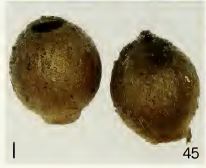Caryomyia viscidolium
Caryomyia viscidolium Gagne, new species
Hosts: Carya ovata, tomentosa, glabra, texana
Gall (Figs. 25, 43-45): Occasional, found on Eucarya hickories; on upper leaf surface, between veins; 3.0-4.1 mm in height, spheroidal, longer than wide, base broadly rounded to truncate in profile, apex with small central nipple surrounded by extensive areola that eventually separates from gall; surface resinous, especially on young galls, sticky, smooth except for scattered minute resin dots, areola paler than surrounding surface; base with wide, deep, circular indentation; wall firm, brittle, al- most uniformly thin, larval chamber glabrous, with longitudinal ridges. This gall and that of the unrelated C. turbanella are the only Caryomyia galls that occur exclusively on the upper leaf surface of hickories. For notes on galls of related species, see under C. cilidolium.
Affinities. — See under C. cilidolium. [C cilidolium: Caryomyia cilidolium, C. hirtidolium, C. tuberidolium, and C. viscidolium form similarly shaped, spheroidal, thin walled galls (Figs. 43-52). At their apex is a large, circular areola surrounding a small central nipple. With a little pressure the circular apex can be broken off as a unit from the rest of the gall and forms the exit from which pupae emerge in spring. Galls of C. cilidolium occur only on bitternut of the Apocarya section of Carya, usually on the lower surface, and are covered with sparse, fine, short hairs. The other three species of this group occur on the Eucarya section. Galls of C. hirtidolium are hairy, much more so than those of C. cilidolium, so that the long hair obscures the gall surface. Galls of C. tuberidolium and C. viscidolium are both sticky, the former very much so and also bumpy and more spherical, the latter merely slightly resinous and smooth. A major difference between these two last species is that C. tuberidolium occurs on the underside of the leaf (except for one example known to me) while C. viscidolium occurs on the upperside. This difference indicates a different egg-laying strategy by the female. The pupal stages are known for all except C. hirtidolium, both sexes for C. cilidolium and C. viscidolium, and the female for C. tuberidolium.]
Biological notes. — Pupae break out of the weak cap at the gall's apex. Emergence occurs in April.
Range: AR, CT, IL, IN, KY, MD, MA, MS, NH, NJ, NY, NC, OH, PA, VA, DC,WV
”- Raymond J. Gagne: (2008) The Gall Midges (Diptera: Cecidomyiidae) of Hickories (Juglandaceae: Carya)©
Reference: https://www.biodiversitylibrary.org/page/38636642#page/92/mode/1up







